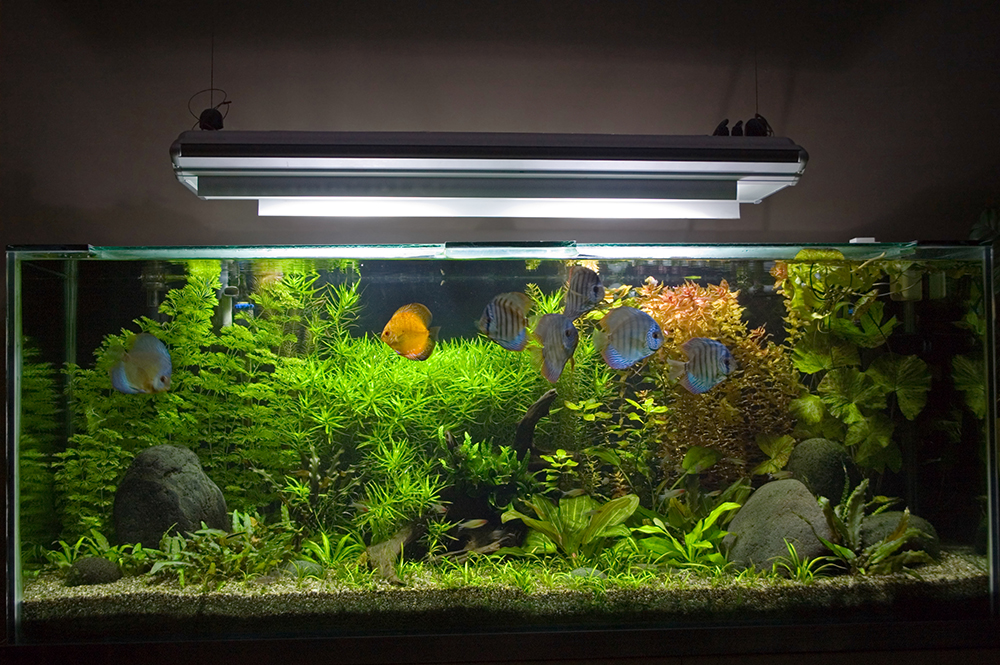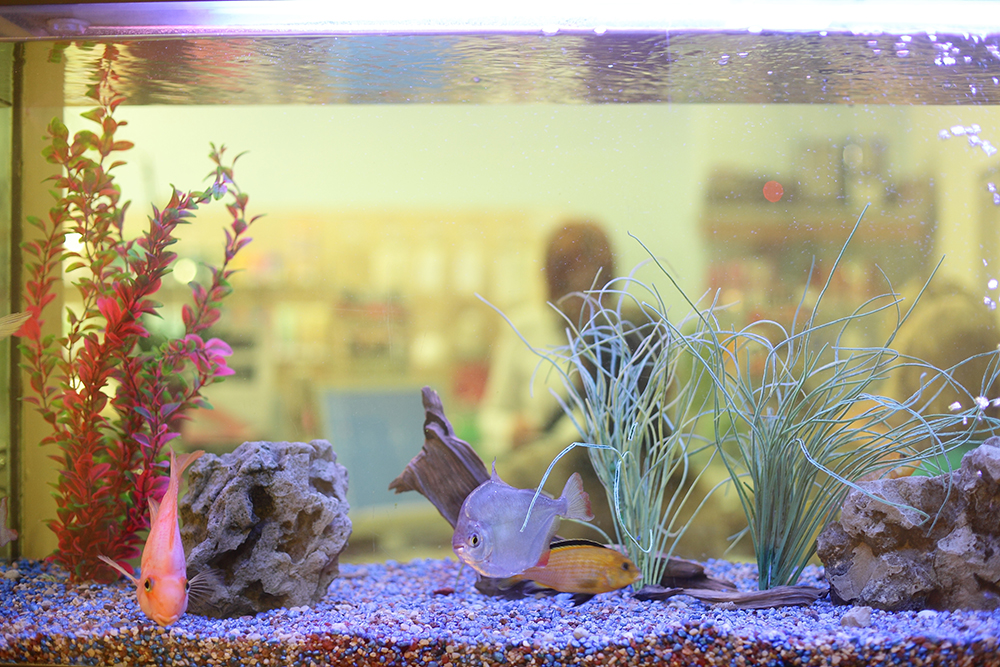
Aquarists' Guide
Aquariums Animate, Decorate and Soothe
 A healthy aquarium isn't hard to maintain, but does require careful preparation. A healthy aquarium isn't hard to maintain, but does require careful preparation.
|
Aquariums house beautiful animals and plants, are entertaining and proven stress relievers, and can be educational, too! As with caring for any living being, aquatic pets require regular attention for their welfare, and to a beginner, the process may seem overly complicated. But in truth, the opposite is true: aquatic pets are among the easiest to care for, and may be surprisingly inexpensive. Once you have your aquarium properly up and running, it is primarily a matter of regular observation and maintenance.
If you want an aquarium in your home – great! It can be an incredibly rewarding experience. Just make sure you enter into this hobby prepared to spend some time choosing the type of fish and designing a system to help them thrive while reducing your maintenance load.
Why Keep Ornamental Fish?
The keeping of ornamental fish (a generic term referring to aquatic pets that includes fish, invertebrates, corals, and live rock) is of great interest, joy and comfort to a large segment of the world population. The connection with nature inside the home is one of the easiest ways to help children get more in touch with the world around them. On top of that, Ornamental fish have been shown to provide health benefits, including helping people suffering from dementia and alzheimer's:
 This guide presented as part of NAIA's mission to promote and preserve domestic animals. This guide presented as part of NAIA's mission to promote and preserve domestic animals.
|
Fish keeping also improves the world we live in as captive bred species of fish and corals have helped reduce that which is taken from the wild as well as helping to replenish depleted supplies, including some that are or were threatened. In some African and South American regions, the harvesting of fish improves the environmental conditions by eliminating what would be large die offs that would otherwise have huge negative implications for the aquatic environment. Harvesting also acts as a revenue source to maintain native residents (see project Piaba as an example). Additionally, live fish are used in many research projects that have led to health improving medical advancements which provide a greater good for the world population. Lastly, keeping fish helps all of us understand the interconnection between fish and planetary ecosystem health.
Before You Get Started
So you want an aquarium? Three things to consider before you get started are:
Getting Started
If you know you will have the time, space, and budget for an aquarium, it's time to lay the groundwork for your new hobby!
First, make a list of the fish and other aquatic animals you are interested in, then research them for size, behavior, and water preference. Researching should winnow your list down significantly, removing from consideration fish that will grow too large for your aquarium, attack tank mates, or require special Ph, salinity, or temperature that significantly varies from most of the other critters on your list.
Once your list is complete, figure out your budget and select your aquarium and accessories. Smaller tanks are less expensive to purchase and maintain unless they are so small that they require additional equipment to keep the fish healthy or are too close to the fragile edge that you will always be fighting water quality issues. Another important consideration is that they take up less space, which can make them more suitable for somebody who lives in an apartment or small home.
Larger tanks are more expensive to purchase, but often times require less regular maintenance due to water volume. Of course, they are able to comfortably house more animals, and are less prone to sudden shifts in temperature and water quality. While the final choice is your own, many experts recommend that you get the largest tank that you can afford and fit in your home. The simple reason for this is that many hobbyists become so enthralled with their new aquarium, they quickly wish it were larger!
Now that You Have Your Aquarium -- Hurry up and Wait!
It will likely take an hour or two to set up your aquarium, fill it with gravel, plants, and water (did you remember to treat the water to remove harmful chlorine, chloramine or heavy metals in it?), and get that rewarding feeling once you are done -- but don't jump the gun by putting any animals in it just yet!
Step back and pat yourself on the back for a job well done, and keep an eye on the tank for at least the next day to make sure everything is in proper working order.
Once you are sure there are no leaks or malfunctions (after 24 hours of running time), pick out some of the smaller, heartiest, common fish off the list you made earlier (zebra danios or goldfish are great examples). The size and number of fish is important – at this stage try to limit the number you choose to about one inch of fish per every 10 gallons of water in your tank.
Introduce these fish to your aquarium, and once again: wait. You are going to want your aquarium to cycle, which can take up to 8 weeks. You can speed this process along by using a tank starter which is beneficial bacteria in a bottle or by using a seeded cartridge for your filter or foam bubbler from your local fish store. During this time, watch your tank like a hawk -- change out small amounts of water regularly, be absolutely sure not to overfeed (of course, this is always important even though your fish will always look hungry when you pass by the aquarium), and check ammonia and nitrite levels. You are waiting for bacteria to grow that will naturally break down the ammonia that fish produce through digestion -- as toxic as ammonia is for fish, the bacteria love it, and by eating it, the bacteria actually help keep the aquarium habitable.
 Add new fish to your aquarium slowly -- and avoid adding more than the tank can handle. Add new fish to your aquarium slowly -- and avoid adding more than the tank can handle.
|
Once your ammonia has increased (spiked) and then dropped to almost zero and your nitrite levels have dropped to zero, within 8 weeks typically, you can begin slowly adding more fish and aquatic animals to your aquatic environment, until your "fish list" is complete. This is provided of course that your local fish store agrees that the number and size of fish you have chosen match your aquatic environment. Slow is the most important word here -- adding too many fish at once will stress the tank, and could even force you to cycle it again.
Maintain and Enjoy
With a fully functional and populated aquarium, it should be fairly easy to maintain a safe and clean environment simply by observing and conducting the minor maintenance tasks noted above. When feeding make sure you are feeding only the amount of food your fish can completely consume within about 30-45 secconds. Always, keep a watchful eye on the health and behavior of your animals in order to stay a step ahead of any trouble that may come along. The "an ounce of prevention is worth a pound of cure" saying is especially apt in a tiny ecosystem like an aquarium! From here, keeping fish can be a daily connection with nature and a rewarding hobby that gives more back to you than you give for years to come!
 Discover Animals is a web-based educational resource offered by the NAIA
Discover Animals is a web-based educational resource offered by the NAIA